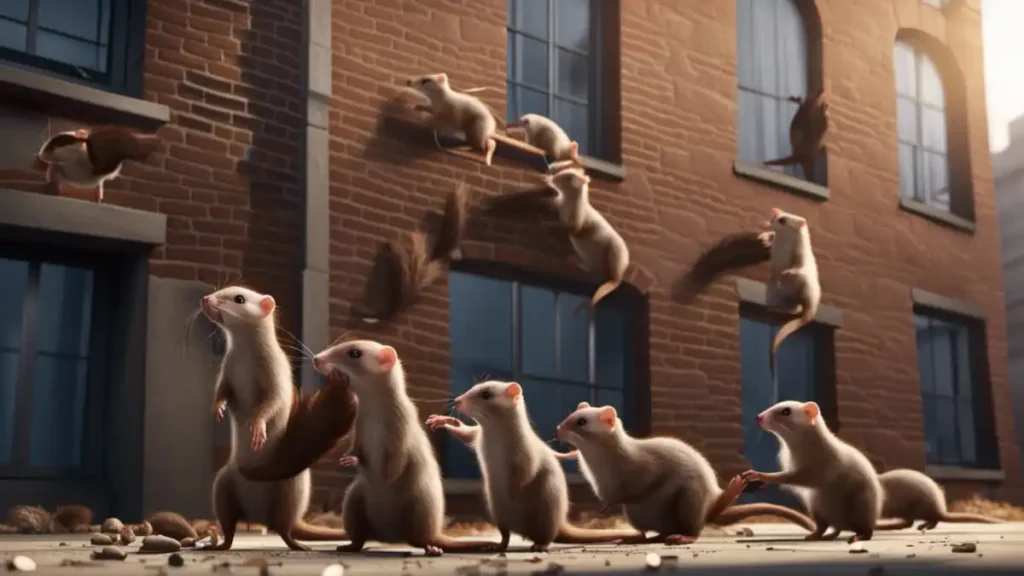The complexity and unpredictability of life make it a fertile breeding ground for problems. Consequently, problem-solving becomes an essential skill to navigate through the varied circumstances that life presents us with, whether in our personal lives, workspaces, or social interactions. However, the effectiveness of problem-solving is not only gauged by the ability to eliminate the present issue but also by the capability to anticipate and mitigate the potential cascading problems that the solution itself might generate. An intriguing perspective to understand this is the concept of the “Weasel Effect.”

In this article:
- What is the Weasel Effect?
- How to Prevent it
- Real-Life Examples
- The Origin of the Weasel Effect
- Conclusion
- About the Author
The Weasel Effect draws its metaphor from the situation where weasels, initially hired to eradicate a rat infestation in a building, end up replacing the problem, creating an even larger issue. This expression highlights the need for strategic thinking in decision-making and has diverse applications from management to networking and beyond.
What is the Weasel Effect?
The “Weasel Effect” is a term coined to describe a paradoxical situation where the solution to a problem unexpectedly morphs into a new, potentially larger problem. It’s an allegorical concept derived from a simple, illustrative story about a group of weasels introduced into an old building to rid it of a rat infestation. Although the weasels were highly effective in solving the initial problem, removing the rats, they then took up residence in the building themselves, creating a new issue that was even more challenging to address. This metaphorical narrative symbolizes a pitfall that can occur in any problem-solving situation across various domains, including management, networking, and life decisions.
The Weasel Effect, therefore, represents a kind of boomerang effect in problem-solving, where the remedy for an initial issue only serves to spawn another, often more complex or substantial, issue. This novel expression serves as a cautionary tale for decision-makers, emphasizing the need for foresight and strategic planning when devising solutions. It suggests that decision-makers should not focus solely on the existing problem but should also consider the potential secondary issues their solutions might engender.

Weasel Effect in Organizations and Life
In the organizational context, managers could fall prey to the Weasel Effect if they hastily implement strategies without considering their long-term implications. This could be seen when a company, in an attempt to improve productivity, imposes strict regulations and longer working hours. The immediate problem of low productivity might be solved, but it could lead to a subsequent issue – low employee morale, burnout, and increased turnover. In this case, the initial problem (rats) has been replaced by a new, bigger problem (weasels).
Life itself is a complex web of problems and solutions, making it a prime arena for the manifestation of the Weasel Effect. One common example is the choice to use a car for all commuting needs in an attempt to save time. While this solves the immediate problem of time constraints, it could lead to larger problems such as a sedentary lifestyle and a larger carbon footprint.
How to Prevent the Weasel Effect?
Preventing the Weasel Effect requires an innovative approach to problem-solving that goes beyond addressing the immediate issue. It requires a level of strategic foresight and comprehensive evaluation that takes into account potential ramifications and secondary effects. Here are some methodologies that can help mitigate the Weasel Effect.
1. Holistic Thinking:
Holistic thinking is a critical ingredient in preventing the Weasel Effect. It involves taking a step back and viewing the problem and its potential solutions in the context of the bigger picture. This perspective allows for the consideration of various interconnected elements and their possible interactions. By anticipating potential consequences and understanding how the parts affect the whole, decision-makers can identify solutions that will not create larger subsequent problems.
2. Scenario Planning:
Scenario planning is a strategic method that organizations use to make flexible long-term plans. It involves creating and analyzing multiple detailed scenarios based on possible future events. This method can help decision-makers identify potential weasels (problems that might arise from a solution) and strategize on how to mitigate or prevent them. It provides an opportunity to examine the different outcomes a solution might produce, thus avoiding tunnel vision and helping to prevent the Weasel Effect.
3. Continuous Evaluation and Feedback:
A continuous process of evaluation and feedback can also serve as a safeguard against the Weasel Effect. As solutions are implemented, regular assessments should be conducted to gauge their effectiveness and identify any emerging problems. This approach ensures that any potential weasels can be detected early and dealt with before they become insurmountable.
4. Stakeholder Engagement and Collaboration:
Engaging stakeholders in decision-making processes and solution development can help prevent the Weasel Effect. Different stakeholders often have varied perspectives and insights that can help identify potential pitfalls or secondary issues that might arise from a proposed solution. Collaborative problem-solving can therefore lead to more robust and sustainable solutions.
5. Iterative Problem-Solving:
Iterative problem-solving, or the process of repeating steps and procedures over time, allows for constant refinement of solutions based on feedback and evaluation. This method offers opportunities to spot potential weasels and to adjust strategies accordingly. It helps ensure that solutions evolve with the changing context, preventing the emergence of new, bigger problems.
6. Building Resilience and Flexibility:
In some cases, the Weasel Effect might not be entirely avoidable. However, building resilience and flexibility into your system can help you adapt to and manage new problems as they arise. This means developing structures and processes that can withstand shocks, bounce back from setbacks, and adapt to new conditions.
Real-Life Examples
The Weasel Effect, while theoretical, finds resonance in numerous real-life situations across a variety of domains. The following examples illustrate its prevalence and underscore the importance of strategic foresight in problem-solving.
1. Urban Planning and Transportation:
In many major cities around the world, planners in the mid-20th century aimed to solve the issue of increasing traffic congestion by constructing more roads. While this might have initially eased congestion, it ultimately led to what’s known as induced demand, where more roads invite more cars, which then leads to more traffic.

Hence, the solution of building more roads (the weasels) eliminated the problem of traffic congestion (the rats) but resulted in a larger issue of increased vehicle usage and worsening traffic congestion.
2. The Introduction of Cane Toads in Australia:
In 1935, Australia introduced the cane toad from Hawaii to control the native grey-backed cane beetle damaging the country’s sugar cane crops. However, the cane toads, with no natural predators, proliferated massively and began impacting local fauna through predation and competition for resources. Thus, the solution of using the cane toads (weasels) to control the cane beetles (rats) led to the larger problem of an ecological imbalance.
3. The Antibiotics Overuse:
For many decades, antibiotics have been used extensively to treat bacterial infections, saving countless lives. However, the overuse of these drugs has led to the emergence of antibiotic-resistant bacteria, creating a new public health crisis.

Here, the solution of widespread antibiotic use (weasels) eliminated the problem of bacterial infections (rats) but led to a larger problem of antibiotic resistance.
4. The Financial Crisis of 2008:
Leading up to the financial crisis of 2008, many financial institutions were investing heavily in complex financial products like mortgage-backed securities to gain high returns. While these instruments solved the immediate problem of the demand for higher profits (rats), their risky nature and the lack of understanding of these instruments (weasels) led to a catastrophic financial crisis, a much bigger problem.
5. The Rise of Single-Use Plastic:
Single-use plastics, particularly in packaging, were initially embraced as a solution to issues of convenience and hygiene. However, as their use became ubiquitous, they led to significant environmental problems, including pollution and harm to wildlife. The solution of single-use plastics (weasels) addressed the problem of convenience and hygiene (rats) but led to a larger issue of environmental damage.
6. The Use of DDT in Mosquito Control:
In the mid-20th century, DDT was widely used for mosquito control to curb diseases like malaria. Although effective initially, overuse led to the emergence of DDT-resistant mosquitoes and negatively impacted various other wildlife species and the environment due to its persistence and bioaccumulation.

The solution of using DDT (weasels) did manage to control the mosquitoes (rats), but it led to larger problems, including resistance and environmental damage.
These real-life examples highlight the Weasel Effect’s presence in our societies and ecosystems and the significant impact it can have. They underscore the necessity of looking beyond immediate solutions and understanding the broader, long-term implications of our actions. By doing so, we can work towards finding solutions that don’t just eliminate present problems but also prevent the creation of larger issues in the future.
The Origin of the Weasel Effect
The birth of the term “Weasel Effect” came about from a quest for fresh and innovative ideas in the field of business management, intended to enrich one of my Blogs, Ciberforma.
During one of those reflective moments, I stumbled upon the intriguing tale of weasels hired to oust rats from a building. At first glance, it seemed a straightforward and efficient solution, but it morphed into a larger problem when the weasels became a new nuisance.
This narrative, albeit peculiar, caught my attention due to its relevance to the world of management. I asked myself, how many times have companies implemented solutions that seemed perfect at the outset, only to find out that these very solutions created new challenges? This pattern of unintended consequences struck me with its parallel to the tale of the weasels and the rats.
As I delved deeper into this phenomenon, I became aware of a gap in the management lexicon. There existed no phrase that could adequately encapsulate this specific situation. This void, I realized, made it harder to report and comprehend such complex situations. Therefore, with humble audacity, I decided to coin a new phrase.
And thus, the “Weasel Effect” was born. A term designed to capture the essence of those moments when an ostensibly effective solution transforms into a source of new problems. The term, inspired by the tale of weasels and rats, now serves as a crucial warning of the need to consider the potential unintended consequences of our actions.
With the “Weasel Effect”, I hope to have contributed in some way to enriching the management vocabulary, facilitating discussion and understanding of the complex dynamics that govern the corporate world. While it might seem a small contribution, I find satisfaction in having had the opportunity to bring something new to this field of study.
Conclusion
The Weasel Effect, while a freshly minted concept, captures a recurring and universal phenomenon in problem-solving – the unintended creation of larger issues while addressing an immediate problem. From urban planning to corporate management, its relevance and implications are far-reaching, underscoring the need for holistic, strategic thinking. The creation of this term aims not just to enrich the management vocabulary, but to foster awareness about the potential pitfalls of immediate solutions and the importance of considering long-term impacts.
Ultimately, the Weasel Effect serves as a reminder that in our quest for solutions, we must ensure we aren’t inviting new, larger problems into our homes. While its mitigation may seem daunting, approaches such as holistic thinking, scenario planning, continuous evaluation, stakeholder engagement, iterative problem-solving, and building resilience offer a roadmap towards more sustainable problem-solving strategies. By bearing the Weasel Effect in mind, we can navigate the complexities of decision-making with greater foresight, creating not just immediate solutions, but lasting, beneficial change.
About the Author
This article was written by Miguel Vieira Pinto, who holds a degree in Industrial Engineering and Management and is the CEO and founder of Ciberforma, the company that owns the Network Encyclopedia website.
There is also a different version of this article, published in Portuguese. You can find it here: Efeito Doninha na Gestão de Empresas.